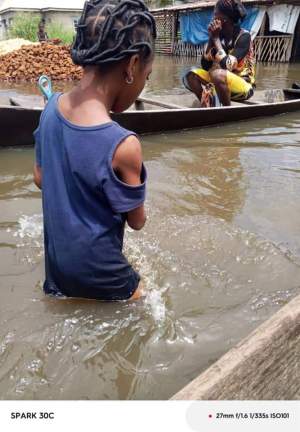The Federal Government has forecast heavy rainfall over a five-day period that may lead to flooding across 15 states in the North and 68 locations.
This comes as the National Emergency Management Agency said a total of 140,228 people in 21 states have been affected by floods so far in 2025.
The heavy rainfall warning, issued on Sunday by the National Flood Early Warning Systems Centre of the Federal Ministry of Environment, called on stakeholders and residents to take urgent precautionary measures.
According to the centre’s flood prediction obtained by our correspondent, the affected areas are expected to experience rainfall likely to cause flooding from August 10 to August 14.
The centre said the listed “locations and their environs are likely to witness heavy rainfall that may lead to flooding within the period of prediction.”
The areas and the locations are Adamawa State (Jimeta, Mubi, Mayo-Belwa, Wuro-Bokki, Yola, Farkumo); Bauchi State (Jama’a); Nasarawa State (Keffi); Kaduna State (Jaji, Kafanchan, Zaria, Birnin-Gwari); Katsina State (Katsina, Bindawa, Kaita); and Kebbi State (Kamba, Kangiwa, Kalgo, Ribah, Sakaba, Saminaka, Gwandu, Jega, Bunza, Birnin Kebbi, Bagudo, Argungu).
Others are Kano State (Bebeji, Gwarzo, Karaye, Sumaila, Tundun-wada); Niger State (Rijau, Ibi, Chanchaga, Magama, Mashegu, Minna, Mokwa, New-Bussa, Sarkin Pawa, Wushishi); Taraba State (Duchi); Jigawa State (Miga, Ringim, Hadejia, Dutse); and Yobe State (Potiskum, Dapchi, Gasma, Gashua, Jakusko).
Also on the list are Zamfara State (Kaura Namoda, Maradun, Shinkafi, Bungudu, Gusau); Sokoto State (Sokoto, Gagawa, Gada, Goronyo, Isa, Wamakko, Silame, Makira); Borno State (Bama); and Kwara State (Jebba).
Figures from NEMA’s latest flood dashboard, obtained on Sunday, showed that the disaster had displaced 49,205 residents, damaged 10,663 houses, and affected 9,454 farmlands in several communities.
The floods, which have struck 52 local government areas, have hit Imo, Rivers, Adamawa, Abia, and Delta states the hardest, with Imo recording 28,030 affected residents. Rivers recorded 22,345; Adamawa, 12,613; Abia, 11,907; and Delta, 8,810.
Other affected states are Borno (8,164), Kaduna (7,334), Bayelsa (5,868), Lagos (5,793), Akwa Ibom (5,409), Niger (3,786), Ondo (3,735), Edo (3,234), Kogi (2,825), Sokoto (1,916), Kwara (2,663), Kano (1,446), Jigawa (1,428), Gombe (972), Anambra (925), and the Federal Capital Territory (1,025).
The data also showed that Imo State had the highest number of displaced persons at 15,107, followed by Rivers with 9,645, Adamawa with 5,808, and Abia with 4,896.
Akwa Ibom recorded 2,645 displaced persons, Borno had 2,436, Edo reported 2,079, and Niger recorded 1,612.
Other states include Lagos with 1,149 displaced residents, Delta with 777, Kaduna with 662, Sokoto with 626, Anambra with 816, Ondo with 363, Gombe with 365, and Jigawa with 219. No displacement was recorded in Bayelsa, the Federal Capital Territory, Kano, Kogi, and Kwara states.
NEMA’s data also revealed the demographic toll of the disaster, stating that 28,505 men, 43,531 women, 62,393 children, 5,799 elderly persons, and 1,887 persons with disabilities are among those impacted.
The report further showed that 10,663 houses were damaged by the floods, with Adamawa State recording 1,121; Niger, 291; Lagos, 1,164; Borno, 716; Abia, 110; Akwa Ibom, 2,727; Delta, 136; Edo, 59; Gombe, 162; Imo, 728; Jigawa, 247; Kaduna, 1,008; Kano, 241; Kogi, 892; Ondo, 407; Rivers, 121; Sokoto, 175; Anambra, 17; Bayelsa, 224; and the Federal Capital Territory, 117.
NEMA identified resource shortage (68.52 per cent), inaccessibility (17.59 per cent), security risk (6.48 per cent), poor coordination (6.48 per cent), and community resistance (0.93 per cent) as the major challenges in the aftermath of the floods.
The agency listed food, shelter, nutrition, livelihood support, health services, water, sanitation and hygiene, education, protection, and security as the priority needs of the affected population.
The agency has so far confirmed 191 deaths, 94 missing persons, and 239 injuries this year.
In comparison, the 2024 floods affected 5,264,097 people across 35 states and 401 LGs, displaced 1,243,638 people, killed 1,237, and injured 16,469.
The floods also destroyed 116,172 houses and damaged 1,439,296 hectares of farmland, highlighting the scale of Nigeria’s recurring flood crisis.
Speaking with our correspondent on Sunday, the National Chairman of the Nigerian Institution of Water Engineers, Joshua Sanga, said flood disasters were exacerbated by climate change.
He added that the aftermath of a flood is usually more serious than the flooding itself, owing to the huge humanitarian crisis and health hazards posed to communities and people.
He explained that perennial flooding in Nigeria is not solely attributable to the release of excess water from the Lagdo Dam in Cameroon, as the country had recorded catastrophic flooding incidents even before the construction of the dam.
Other contributing factors, he noted, include high-intensity rainfall, excessive run-off and low soil permeability, siltation of water bodies, blockage of drainages, and the release of water from dams, especially those situated along the River Niger.
“Studies have also shown that peak floods usually occur from July to October in Nigeria.
“The presidential initiative in constituting the presidential committee for the development of a comprehensive plan of action for preventing flood disasters in Nigeria in 2023 was commendable.
“However, the recommendations of other committees established in times past were yet to be either implemented or fully implemented.
“This includes the construction of buffer dams in Lokoja around the confluence and in Onitsha, which is still pending. Excess flood water curtailed by buffer dams can be rechannelled for other beneficial use afterwards.
“Although, Nigeria has more than 433 dams, their use is most of the time multipurpose. Flood predictions by the Nigerian Hydrological Services Agency provide valuable information for planning against floods,” he stated.
He recommended that the government should consider and implement recommendations made by the institution, the presidential committee on flood, and those of relevant previous study groups in the short, medium and long term in collaboration with the relevant professionals, ministries, departments and agencies.
“The recent flooding and the attendant casualties in Mokwa, Niger State and some parts of Yola, Adamawa State, are regrettable.
“Stemming the tide of flooding requires the cooperation of all stakeholders.
“It is pertinent that the Federal Government drive the process for the implementation of lasting solutions towards addressing the menace of perennial flooding in Nigeria and enhancing flood preparedness to avert the colossal loss of lives, properties, and displacement of man, animals and damage to the environment,” he added.









